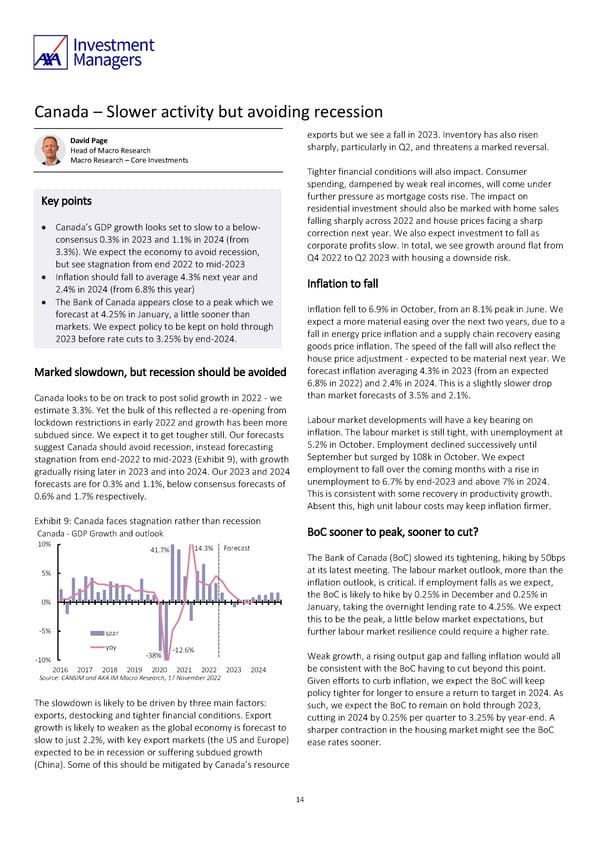Canada – Slower activity but avoiding recession David Page exports but we see a fall in 2023. Inventory has also risen Head of Macro Research sharply, particularly in Q2, and threatens a marked reversal. Macro Research – Core Investments Tighter financial conditions will also impact. Consumer spending, dampened by weak real incomes, will come under Key points further pressure as mortgage costs rise. The impact on residential investment should also be marked with home sales • Canada’s GDP growth looks set to slow to a below- falling sharply across 2022 and house prices facing a sharp consensus 0.3% in 2023 and 1.1% in 2024 (from correction next year. We also expect investment to fall as 3.3%). We expect the economy to avoid recession, corporate profits slow. In total, we see growth around flat from but see stagnation from end 2022 to mid-2023 Q4 2022 to Q2 2023 with housing a downside risk. • Inflation should fall to average 4.3% next year and 2.4% in 2024 (from 6.8% this year) Inflation to fall • The Bank of Canada appears close to a peak which we forecast at 4.25% in January, a little sooner than Inflation fell to 6.9% in October, from an 8.1% peak in June. We markets. We expect policy to be kept on hold through expect a more material easing over the next two years, due to a 2023 before rate cuts to 3.25% by end-2024. fall in energy price inflation and a supply chain recovery easing goods price inflation. The speed of the fall will also reflect the house price adjustment - expected to be material next year. We Marked slowdown, but recession should be avoided forecast inflation averaging 4.3% in 2023 (from an expected 6.8% in 2022) and 2.4% in 2024. This is a slightly slower drop Canada looks to be on track to post solid growth in 2022 - we than market forecasts of 3.5% and 2.1%. estimate 3.3%. Yet the bulk of this reflected a re-opening from lockdown restrictions in early 2022 and growth has been more Labour market developments will have a key bearing on subdued since. We expect it to get tougher still. Our forecasts inflation. The labour market is still tight, with unemployment at suggest Canada should avoid recession, instead forecasting 5.2% in October. Employment declined successively until stagnation from end-2022 to mid-2023 (Exhibit 9), with growth September but surged by 108k in October. We expect gradually rising later in 2023 and into 2024. Our 2023 and 2024 employment to fall over the coming months with a rise in forecasts are for 0.3% and 1.1%, below consensus forecasts of unemployment to 6.7% by end-2023 and above 7% in 2024. 0.6% and 1.7% respectively. This is consistent with some recovery in productivity growth. Absent this, high unit labour costs may keep inflation firmer. Exhibit 9: Canada faces stagnation rather than recession Canada - GDP Growth and outlook BoC sooner to peak, sooner to cut? 10% 41.7% 14.3% Forecast The Bank of Canada (BoC) slowed its tightening, hiking by 50bps 5% at its latest meeting. The labour market outlook, more than the inflation outlook, is critical. If employment falls as we expect, 0% the BoC is likely to hike by 0.25% in December and 0.25% in January, taking the overnight lending rate to 4.25%. We expect this to be the peak, a little below market expectations, but -5% saar further labour market resilience could require a higher rate. yoy -12.6% -10% -38% Weak growth, a rising output gap and falling inflation would all 2016 2017 2018 2019 2020 2021 2022 2023 2024 be consistent with the BoC having to cut beyond this point. Source: CANSIM and AXA IM Macro Research, 17 November 2022 Given efforts to curb inflation, we expect the BoC will keep policy tighter for longer to ensure a return to target in 2024. As The slowdown is likely to be driven by three main factors: such, we expect the BoC to remain on hold through 2023, exports, destocking and tighter financial conditions. Export cutting in 2024 by 0.25% per quarter to 3.25% by year-end. A growth is likely to weaken as the global economy is forecast to sharper contraction in the housing market might see the BoC slow to just 2.2%, with key export markets (the US and Europe) ease rates sooner. expected to be in recession or suffering subdued growth (China). Some of this should be mitigated by Canada’s resource 14
 AXA IM Outlook 2023 full report Page 13 Page 15
AXA IM Outlook 2023 full report Page 13 Page 15